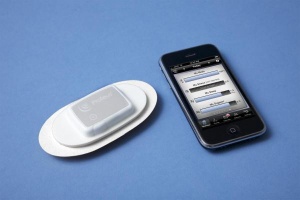
Proteus Biomedical's Raisin Personal Monitor
Think there’s not enough evidence to prove the efficacy of wireless, home-based patient monitoring?
Robin Felder, associate director of clinical chemistry and toxicology and a pathology professor at the University of Virginia, disputes that notion. Felder likes to cite a 2007 paper in the Journal of Telemedicine and e-Health. That paper showed a 74 percent reduction in the cost of caring for patients in assisted living with “passive” monitoring devices, and, notably, the rate of urinary tract infections in the study group dropped to near zero.
To Felder, who conducts research in medical automation, robotics and process improvement in clinical laboratories, the key word is “passive.” This means you don’t have to think about it, even to put it on.
Felder, who spoke during a “Views from the Top” session at last week’s HIMSS conference in Orlando, Fla., said that 95 percent of home blood-pressure monitors eventually get stashed in a drawer because patients have to go out of their way to use the devices. The presentation highlighted a new generation of passive wireless patient monitoring that’s part of something Felder called “wellness support.” This is the integration of multiple sources of diagnostic information, covering traditional healthcare encounters, lab testing, pharmacy, molecular biology and lifestyle.
In the near future, expect to see underwear and other everyday garments with embedded blood pressure and pulse sensors. “It’s more passive than strapping something on your arm,” Felder said.
For about a penny, pharmaceutical companies can add a digestible chip to a pill to indicate whether the patient took the drug, monitor stomach pH and other vitals, and transmit readings to a cell phone via Bluetooth.
Felder has worked with companies that have developed contact lenses and other eye inserts with sensors that automatically measure glucose levels in tears of diabetic patients, also sending data to cell phones. “The eye as a window to health” is how Felder described it. Studies are underway at the University of California, Santa Cruz, and the University of Maryland-Baltimore, as well as in the private sector through a company called Medical Robotics that Felder has an interest in.
The sensors being used in the eye tests were developed originally for the automotive industry, so they are cheap—maybe a dime each—and plentiful.
All of these devices can feed data to integrated health and wellness records, with “information support” to help people maintain healthy lifestyles, according to Felder. They’re part of an emerging field called home health IT, which presents a new revenue opportunity in a place Felder referred to as the “Medical Cloud,” which pulls together information from multiple sources so clinicians can provide wellness support to manage patients at home.
Felder showed a slide depicting common bathroom fixtures with built-in sensors to measure weight, body temperature and other vitals, then transmit data to web-based apps for aggregation and interpretation. In one image, a screen embedded in a bathroom mirror displayed wellness data as a man was shaving. He also talked of a passive monitoring environment in which a toilet could record the patient’s body temperature, pulse and body fat, while also analyzing urine for protein and glucose levels.
Data collected can support “action-inspired instruction,” with real-time, patient specific coaching, according to Felder.
What these devices cannot yet do is provide continuous, passive monitoring of blood pressure of patients, even while they sleep. “That’s kind of the Holy Grail,” Felder said. Polysomnography is the current way of doing that, and it’s not exactly natural. “We’re going to wire you up, now get a good night’s sleep,” Felder joked.
The U. Va. professor discussed his attempt at reaching that lofty goal. WellAWARE Systems (short for Automated Wellness Alerting and Reporting Environment), a Glen Allen, Va., a not-for-profit company Felder founded and serves on the board of, is testing passive sleep monitoring in an assisted-living facility with a sensor array aimed at the bed, a data manager and an analysis/reporting engine that can identify problems and notify caregivers.
Nurses keep tabs on patients via a computer-based dashboard that prioritizes cases depending on real-time condition readings. “Future iterations will actually suggest solutions to the people doing the monitoring,” Felder said.



















